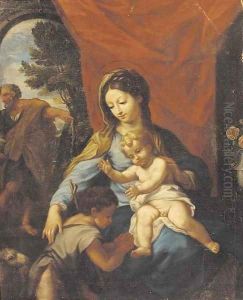Francesco Trevesani Paintings
Francesco Trevisani was an Italian Baroque painter who was born in Capodistria, now Koper, Slovenia (then part of the Republic of Venice) in 1656. He is known for his elegant and well-crafted religious compositions, as well as his portraits and mythological scenes. Trevisani's style was influenced by the grandeur of the Roman Baroque and was marked by clear, bright colors, graceful figures, and a certain emotional restraint.
Trevisani received his initial artistic training from his father, who was a minor painter. In his early years, he was also influenced by Antonio Zanchi in Venice and later by the dynamic style of Luca Giordano. It was, however, his move to Rome in 1678 that would have a profound impact on his career. In Rome, Trevisani came under the patronage of Cardinal Ottoboni, who was a nephew of Pope Alexander VIII. This connection provided him with numerous commissions from the church and the Roman aristocracy.
Throughout his career in Rome, Trevisani was involved in significant artistic projects, including the decoration of chapels and altarpieces for various churches. He painted frescoes and altarpieces, and his works are found in many Roman churches such as San Silvestro in Capite and Santa Maria in Montesanto. His style was influenced by the works of Carlo Maratta, who was the leading painter in Rome at the time, and his art reflects a blend of the Bolognese classicism and the Roman Baroque.
Trevisani also became a respected portraitist, capturing the likenesses of many important figures of his time. His portraits are characterized by their refined elegance and meticulous attention to detail. Despite the prominence of the Baroque style in his work, Trevisani's portraits often exhibit a clarity and simplicity that link them to the classicist tradition.
Trevisani's talent was recognized by his election to the prestigious Accademia di San Luca in Rome, where he later served as the president. His reputation extended beyond Italy, and his works were collected by patrons across Europe. His influence was felt by many younger artists, and he played a role in shaping the late Baroque and early Rococo styles.
Francesco Trevisani's career spanned over seven decades, and during this time, he witnessed the transition from the high Baroque to the Rococo. He continued to paint until his death in 1746 at the age of 90. Today, his works can be seen in major museums and collections around the world, showcasing his contribution to the Italian Baroque movement.
